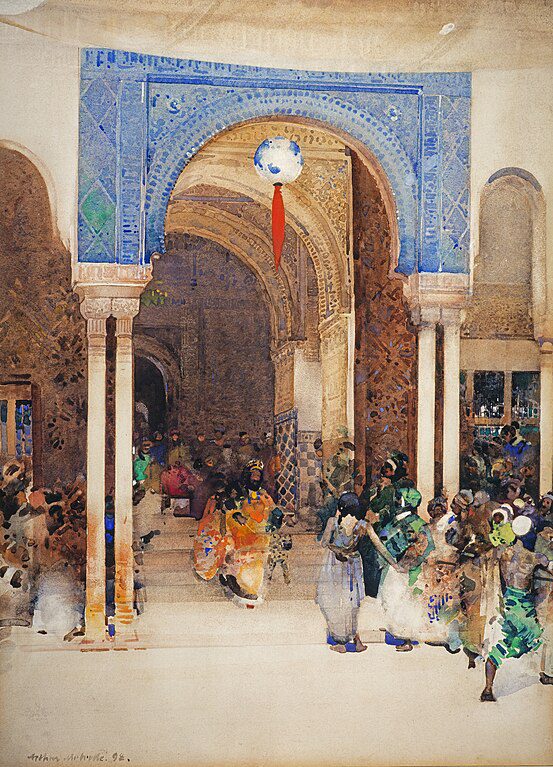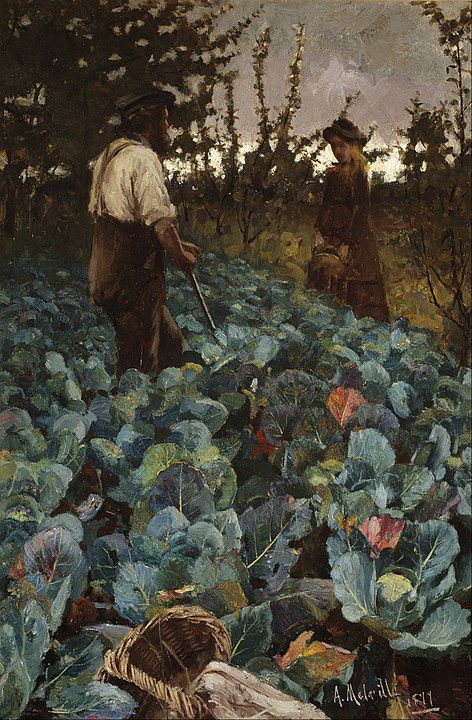
Arthur Melville (1855-1904) stands as a remarkable figure in the panorama of Scottish art, celebrated for his pioneering spirit and exceptional use of watercolor. Born in Loanhead of Guthrie, near Arbroath, Scotland, Melville embarked on a journey that would see him emerge as one of the late 19th century’s most innovative and influential watercolourists. His journey through art was one marked by bold experimentation, a luminous palette, and a remarkable ability to capture light and atmosphere that distinguished him from his contemporaries.
Melville’s artistic journey began at the Edinburgh Royal Institution, where his talent quickly became apparent. His quest for artistic growth led him to Paris, where he studied at the Académie Julian. It was here, amidst the avant-garde movements of the time, that Melville began to forge his distinctive style. However, it was his travels to the Middle East, North Africa, and Spain that profoundly shaped his aesthetic. The intense light and vibrant colors of these landscapes would forever alter his approach to watercolor, pushing him to develop a technique that was both innovative and strikingly modern.

One of Melville’s most significant contributions to art was his development of the “blottesque” technique, a method where partially dry paper is used to absorb colors, creating effects that were both spontaneous and luminous. This technique allowed Melville to achieve a remarkable intensity and purity of color, capturing the ephemeral qualities of light and atmosphere with a brilliance that was unparalleled at the time. His works, such as “The Sapphire Sea” and “An Arab Interior,” exemplify this technique, showcasing his ability to blend realism with a poetic sensibility.
Influence of Travel
Melville’s travels not only influenced his technique but also the subjects of his art. He often depicted scenes from his journeys, ranging from the bustling streets of Cairo to the serene landscapes of Scotland. His ability to capture the essence of a place, to convey its atmosphere and light, made his work deeply evocative and resonant with viewers. Melville’s paintings are not mere representations; they are imbued with a sense of the sublime, a reflection of his lifelong fascination with the interplay of light and color.

Upon his return to Britain, Melville became a central figure in the Glasgow Boys group, a collective of artists who sought to challenge the conventions of Victorian art. Through exhibitions and collaborations, he played a crucial role in promoting a more naturalistic and progressive approach to painting in Scotland. Despite his association with the Glasgow Boys, Melville’s style remained unique, characterized by his adventurous use of color and innovative techniques.
Acclaim & Success
Melville’s career was marked by critical acclaim and commercial success, yet he remained committed to pushing the boundaries of his medium. His later works, such as “The Bass Rock,” reflect a continued evolution in his style, incorporating more expressive and abstract elements. These paintings hint at the directions his art might have taken had his life not been cut short by typhoid fever in 1904, at the age of 49.

Arthur Melville’s legacy is that of an artist who continually sought to explore and innovate, whose mastery of watercolor set new standards for the medium. His work not only influenced his contemporaries but also anticipated some of the developments in early 20th-century art, including the move towards abstraction and the exploration of color as an emotional force. Today, Melville is celebrated for his contribution to Scottish art and his role in the broader narrative of watercolor painting. His paintings, with their vibrant colors and innovative techniques, continue to inspire and captivate audiences, a testament to his enduring significance in the history of art.




